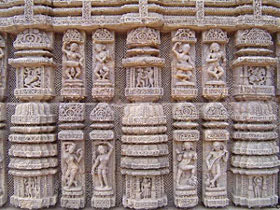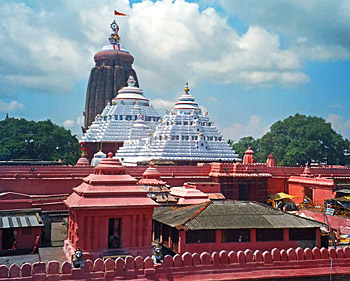Musical tradition in Odissi follows a rather long and rich period of growth and development. Odissi follows the Udramagadhi style of Indian Classical Music. The origins of Udramagadhi itself go back a rather long way, a testimony to the antiquity of the Odissi style of music. Udra style gets mention in Bharata`s Natyashastra. According to Bharata, the authorities on dramaturgy have enumerated four Pravrtti - local usages or styles- Avanti, Daksinatya, Pancali and Odhramagadhai. Thus, there were four principal styles popular in the time of Bharata. From Orissa`s ancient history, it is known that close cultural interaction was built between Udra and Magadha as they shared the same border and it was no wonder if both of them shared the same Natya style. It may be mentioned here that `Natya` included also Sangeet. The Pravrtti called Odhramagadhai was employed in the regions of Anga, Vanga, Kalinga, Vatsa, Udhramagadha, Paundra, Nepala, Antargira, Bahirgira, Pravariga, Mahendra, Malada, Mallavarta, Brahmottara, Bhargava, Margava, Pragjyotisa, Pulinda, Videhas, Tamralipta, Prariga and Pravrta. Ancient Anga, Kalinga and Udra are included in modern Orissa.
The musical glory of Odissi finds mention even in emperor Kharavela`s stone inscription in Bhubaneshwar. The most powerful ruler of Chedi dynasty, Jaina Emperor Kharavela`s reign (2nd to 1st centry B.C.) is described in detail in the inscriptions engraved in the Khandagiri Udayagiri hills near Bhubaneshwar. They record the first thirteen years of Kharavela`s reign. There it is described that in the 3rd year of his reign "Kharavela proficient in Gandharva Vidya entertained the inhabitants of his capital through performance of dance and music- both vocal and instrumental and drama". The auditorium he built at Udaygiri hill still stands in Bhubaneshwar.
Odissi in Religious Works
 In Lalitgiri and Udayagiri Buddhist Universities built by the Bhaumakara rulers one finds the beautiful statues of Buddhist female goddesses of the Vajrayana denomination in dancing pose. In various temples built during various dynasties beautiful sculptures have been carved showing female danseuses and musicians. The sculpture of female musicians in Konark is well known all over the world. All Hindu temples in Orissa had also Nata Mandira (auditorium) where every night music and dance were performed to please the gods. Devadasis, locally known as Maharis used to perform such dance and music in the temple of Lord Jagannath. Brahmins known as `Sangeet Ray` were in charge of such activities. The founders of Ganga dynasty came from South India and revamped the Devadasi system in Puri temple. They also introduced a percussion instrument looking like Dholki (considered very auspicious even today) known as Telingi Bazza (telugu musical instrument).
In Lalitgiri and Udayagiri Buddhist Universities built by the Bhaumakara rulers one finds the beautiful statues of Buddhist female goddesses of the Vajrayana denomination in dancing pose. In various temples built during various dynasties beautiful sculptures have been carved showing female danseuses and musicians. The sculpture of female musicians in Konark is well known all over the world. All Hindu temples in Orissa had also Nata Mandira (auditorium) where every night music and dance were performed to please the gods. Devadasis, locally known as Maharis used to perform such dance and music in the temple of Lord Jagannath. Brahmins known as `Sangeet Ray` were in charge of such activities. The founders of Ganga dynasty came from South India and revamped the Devadasi system in Puri temple. They also introduced a percussion instrument looking like Dholki (considered very auspicious even today) known as Telingi Bazza (telugu musical instrument).
Odissi in Literary Works
Oriya language and literature like many other literature of eastern India claims its ancestry to Charyagitis otherwise known as Baudha Gana Doha. The Dohas and Gitis are composed In Raaga Saberi, Malashri, Pratham Manjari etc. Those are the original Raagas of Orissa. Sangeeta Ratnakar and Chaturdandi Prakashika were the contemporary works of Charyagitis. These treatises have described the nature and style of Charyagitis. The Charya Gitis were composed with Raagas and Dhatus. Out of 18 Raagas described in Baudhagana 15 Raagas also find mention in `Gita Prakash` and `Sangeet Narayan`-two ancient treatises on Odissi music.
During the reign of Ganga dynasty, singers were invited from South India to sing Gitagovindam in Jagannath temple. It is probable that during the reign of these Ganga rulers Urdra-Magadhi style of the north was synthesised with the southern tradition. Gitagovindam mentions Raaga Khamaj Gandhara, Gurjan, Patamanjari or Pratham manjari etc. which were being sung as per the rules mentioned in Natyashastra. Fortunately, the medieval Oriya poets of Orissa mentioned clearly at the beginning of their lyric, the Raaga as well as Tola to be followed in singing that song.
Odissi in Jagannath Temple
 Odissi dance and music are performed in Jagannath temple daily under the vigilant eye of the trainer and strict supervision of a royal representative. The rules are so rigidly followed that for each day of the week the Lord wears cloth of a particular colour, the colours being decided by Swaras as mentioned in Gandharva Samhita. The Binakara Sevaka (one in charge of Veena-playing service) is also instructed to change Swara according to Baara (days of the week). Thus Odissi music including Gitagovindam as performed in Puri temple has kept its pristine originality till date. Even the music taught to Gotipuas in the past in Puri akhras were taught by Puritan teachers.
Odissi dance and music are performed in Jagannath temple daily under the vigilant eye of the trainer and strict supervision of a royal representative. The rules are so rigidly followed that for each day of the week the Lord wears cloth of a particular colour, the colours being decided by Swaras as mentioned in Gandharva Samhita. The Binakara Sevaka (one in charge of Veena-playing service) is also instructed to change Swara according to Baara (days of the week). Thus Odissi music including Gitagovindam as performed in Puri temple has kept its pristine originality till date. Even the music taught to Gotipuas in the past in Puri akhras were taught by Puritan teachers.
Thus there is fairly a long tradition as far as the practice, study and research in Odissi music are concerned.



















